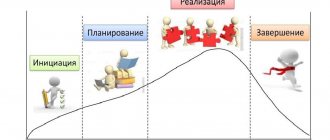110132
0
Author of the article:
Sultanov Iskander Anvarovich
Founder of Projectimo.ru
Recent publications by the author:
Systematic labor standardization project
Implementation of a project to transfer accounting to outsourcing
Anticipation of significant changes in investments
In the modern interpretation, management is a science. And the scientific approach involves a preliminary consideration of such categories as subject, method and classification categories of the phenomenon being studied. Project management occupies a place of significant scientific and practical field in the vast field of management science. This means that penetrating into the innermost corners of knowledge about the optimal ways to implement development tasks, we cannot help but consider the types of projects in all their diversity. To do this, you will need to first classify them according to methodologically sound criteria.
What does the project include?
The concept of it in developed Western countries is broader than it is accepted in our country. For example, the American Institute of Project Management defines it as a certain task with initial data, as well as required goals (results), which determine the method for solving it. This, however, does not say what funds exist to implement the project. In addition, the method of solving a particular problem is not always determined and not only by the goals (results) of its solution. Therefore, we can say that the project includes:
— plan (task, problem);
— means of solution (implementation);
— goals (results).
Project results
A project in a broad sense is something that can change something in the world, in life. Its results from a similar point of view can be both concrete (organization, structure, building, products, etc.) and abstract (experience, knowledge, methods, plans, etc.). If we consider it as a dynamic system, we can distinguish:
— current (technology, documentation, etc.);
- final (profit, product, etc.).
Often a project and its results are presented in the form of a system of goals, which means that the project is a system. In other words, it is a combination of various elements and the connections that arise between them, which ensures the achievement of certain goals.
Practical tips for implementation
In my opinion, most people don't try to be unique. They just decide to do something good and meaningful. If you apply all your skills, then this is quite possible. There is a given - this is the ability to do 2 things to implement projects.
- Create your own scenario to inspire future transformations.
- Stick to a specific script every day. What is done today, tomorrow, next week, next month can be viewed through the creation of your own way of behavior, from the perspective of a full life.
In my opinion, most people think that to make a project a reality, you don’t need to understand all the small details, just the ability to do several cycles at once is enough. In the course of such reasoning, they find themselves trapped in their own narcissism. They spend all their efforts on showing the outside world their unusual abilities and self-confidence. They are often included in the ranks of obvious losers, who simply do not know how, but do not even realize their illiteracy.
I think learning is the most important skill in life. Then you can instantly acquire new knowledge and put it into practice. And, most importantly, you need to know who to learn from.
When a person does not give up when experiencing failures, but gains experience, he strives to change further. For example, many professions require restructuring due to coronavirus and the development of modern technologies. Accountants once worked manually, but now use the 1C program, taxi drivers used walkie-talkies, and now use applications, etc.
Self-discipline is a very important skill in human behavior. Allows you to adapt to a job you don’t like to get high results. If there is no self-discipline, famous gymnasts, swimmers, football players, doctors, and businessmen would not appear.
Anyone who feels bad about humor is unlucky in life - an excellent saying. Others are drawn to people who can joke. In my opinion people are very social and want positive and friendly relationships. They give a person freedom: developing opportunities, rather than wasting time on clarifying relationships. The ability to practically implement projects is an important skill for a person. Everyone needs this skill. This ability can be present from birth, or it can be developed through the acquisition of skills and experience.
The basis on which projects can be classified
Classification of projects can be carried out according to the timing of implementation, scale, quality of their development and implementation, location of implementation, and the size of the resources used. The variety of their species is extremely great in reality. The classification of projects has the following bases:
— structure, composition of the project and subject area that determine its class;
- the field of activity where it is carried out, which determines its type;
- the size of the project, the number of participants, as well as the degree of its influence on the outside world, which determine its scale;
— duration of implementation, determining its duration;
— degree of technological, financial, organizational, technical and other complexity.
Organizational projects
The types of projects are as follows: organizational, social, economic, technical and mixed. Organizational projects are usually associated with the reform of existing enterprises, as well as with the creation of a new enterprise, organization, business entity, or the implementation of some event (seminar, symposium, forum, conference, etc.). Their main characteristic features are the following:
— the goals of the project are defined, but are difficult to quantify, since they are aimed at improving the organization of the system;
— the duration of the implementation and the deadline are set in advance;
— resources are allocated whenever possible;
— the costs of such a project are subject to very careful control from the point of view of the cost-effectiveness of their implementation; adjustments are often necessary during the implementation process.
1.3. Types and types of projects
Projects implemented in different areas by different specialists have significant differences among themselves. Therefore, in order to choose one or another approach to managing a specific project, it is first necessary to understand the features of this particular type or type of project.
Classification of projects can be carried out on various grounds. We will consider only its most common options:
1.3.1. Project types
They differ according to the areas of activity in which the project is carried out:
1. Technical
(construction of a building or structure, implementation of a new production line, software development, etc.);
2. Organizational
(reforming an existing or creating a new enterprise, introducing a new management system, holding an international conference, etc.);
3. Economic
(privatization of an enterprise, introduction of a financial planning and budgeting system, introduction of a new taxation system, etc.);
4. Social
(reform of the social security system, social protection of disadvantaged segments of the population, overcoming the consequences of natural and social shocks);
5. Mixed
(projects implemented in several areas of activity at once - for example, an enterprise reform project, including the implementation of a financial planning and budgeting system, the development and implementation of special software, etc.).
1.3.2. Project classes
They differ in composition, structure and subject area of the project:
1. Mono projects
– individual projects of various types and purposes, having a specific goal, a clearly defined framework for finance, resources, time, quality and involving the creation of a single project team (investment, innovation and other projects);
2. Multiproject
– a complex project consisting of a number of single-projects and requiring the use of multi-project management (reform of existing and creation of new enterprises, development and implementation of in-house multi-project management systems);
3. Megaproject
– targeted programs for the development of regions, industries and other entities, which include a number of single- and multi-projects (“Marshall Plan”, creation of a pan-European market, development of South Korea, etc.).
1.3.3. Project scope
In American practice, there is a division of projects by scale:
1. Small projects
– capital investments up to $10-15 million; labor costs 40-50 thousand man-hours. Examples: pilot industrial installations, small industrial enterprises, modernization of existing production facilities.
2. Megaprojects
– targeted programs containing many interrelated projects united by a common goal, allocated resources and time allotted for their implementation. Distinctive features: capital investments - from $ 1 billion or more, non-traditional forms of financing (equity, mixed) - usually a consortium of firms, labor intensity - 2 million man-hours - for design, 15-20 million man-hours - for construction, 5 -7 or more years is the implementation period.
1.3.4. Types of projects
They differ in the nature of the subject area of the project:
1. Investment
– the main goal is the creation or renovation of fixed assets of organizations that require investment;
2. Innovative
– the main goal is the development and application of new technologies, know-how and other innovations that ensure the development of organizations;
3. Scientific research;
4. Educational;
5. Mixed.
1.3.5. By duration
1. Short
– up to 3 years;
2. Medium term
– from 3 to 5 years;
3. Long term
– over 5 years.
Features of economic projects
The classification of project types also highlights economic ones. They are aimed at restructuring enterprises, privatization, reorganization, improving customs rules, the tax system, etc. Their features are as follows:
— preliminary main final goals are outlined, which can be adjusted during implementation;
— the timing of the project, as well as its individual components, is often adjusted;
— costs are approximately determined, but they are strictly and constantly controlled.
Characteristics of social projects
Social projects are aimed at solving certain social problems. For example, this is the improvement of pension legislation, social security, and the elimination of the consequences of social upheavals and natural phenomena. Other examples can be given. There is a separate classification of social projects, but they all have the following common features:
- goals are outlined in general, but as they are developed and certain intermediate results are achieved, they are adjusted, and qualitative and quantitative assessment is often difficult;
- both the total duration and the timing cannot be clearly determined, so they are probabilistic in nature;
— resources are allocated to the project as necessary, but within the limits of what is possible.
It is projects of this type that have the greatest uncertainty.
Technical projects
They are associated with the development of a new product (type, type, design). Their features are as follows:
— the main final goal is clearly defined, although individual subgoals may be clarified as implementation progresses;
— duration, completion dates are clearly defined in advance and, if possible, observed, however, adjustments are not excluded;
— expenses are clearly planned;
— restrictions in the implementation of the project and its planning are associated mainly with the limit of production capacity.
Main types of design work in construction
Any construction work always begins only after design, consisting of the following stages:
- pre-project preparation activities;
- main design part;
- design of the technological part;
- design of construction organization, including the content of the PIC;
- design of the production part;
- technical and economic assessment of construction and work organization projects;
- coordination of design and estimate documentation;
- expert assessment of design and estimate documentation.
The preparatory stage, in turn, includes the following stages:
- investor's decision on the feasibility of construction work;
- pre-design preparation, including engineering surveys and selection of a site for the construction of the facility;
- design work.
As part of the preparation for construction design, a document is also being developed to justify investment in the facility being built. To do this, the customer must obtain a positive conclusion from the local executive authority, having previously submitted a corresponding petition. Before starting to develop a justification, it is also necessary to issue a design assignment to the general designer.
If work on the construction site will be carried out in stages (several stages), the customer must agree on all measures that will ensure the normal operation of the facilities operating on this site. Only upon completion of all preparatory activities is it possible to proceed directly to the design.
A complex of design work usually consists of several activities:
- design and survey activities;
- field studies;
- design and engineering activities;
- design and technical work;
- design and installation stage.
Next, we will examine each of these types of project activities in more detail.
Project scale
As you can see, the topic “Classification of projects and their types” is quite extensive. Continuing its disclosure, we move on to the next basis of classification. We can distinguish between a megaproject and a small (mini-project). Classification in this case is carried out by scale. Small is small in volume, simple in structure, and has a small number of participants. A number of simplifications are allowed during its development and implementation:
— one person coordinates the work;
— members of the management team for this project are interchangeable;
— implementation schedules are as simple as possible;
— each team member knows his scope of work and tasks;
— the project is implemented by the same composition of performers (team) that started working on it, carried out development, planning, and then design.
Features of megaprojects
Megaprojects are targeted programs. They consist of many smaller ones, which are interconnected and united by some common goal, implementation time and resources. Such targeted programs can be interregional, regional, intersectoral, sectoral, national and international. Their budgets reach hundreds of millions of dollars, and sometimes more. Such programs are coordinated and formed at the interstate and state levels. 5-7 years, and sometimes more, may be the duration of their implementation. It is no coincidence that we highlighted them, revealing such a topic as the classification of projects. Managing this type of project is very complex because it requires taking into account many factors.
The following features are inherent in them:
— the presence of many different performers who specialize in different types of work, which means there is a need to coordinate their actions;
— mandatory consideration of the social and economic conditions of the implementation of this project in a specific place and at a specific time;
— segregation into an independent phase of development of its concept;
— updating the original project plan at different stages of implementation;
— taking into account its uniqueness and specificity;
- the need to develop different plans for its implementation - both operational and strategic;
— mandatory consideration of the probabilistic nature of various indicators and risk;
— constant monitoring of this project, as well as updating its elements.
Design and technical work
An equally important stage in most types of design work in construction is design and technical work, which serves as the main link both in the construction of objects, and in their repair, and in installation work.
This set of activities is carried out by the contractor; responsibility for execution rests with either the contractor or the design organization. The customer in this case is the direct consumer of the service who accepts the result of the work and pays its final cost.
Design at this stage is regulated by the relevant government bodies on the basis of specially developed GOST and SP requirements.
Design and technical work includes the following components:
- Agreement or contract
This is the main document that defines the rights and obligations of the parties involved, regulating their responsibilities and relationships. - Terms of reference
This is documentation that defines the technical and natural conditions for the construction of an object. - Technical proposal (technical and economic report)
Justifies the possibility of the planned construction, contains an expert assessment of the technical specifications and an analysis of the design of the facility. - The sketch part
consists of various drawings and diagrams that describe design solutions, and also determines the purpose and characteristics of the structure being built. - Technical project
is technical documentation in its final form, which describes all devices and adopted decisions of the project. - Detailed design
This set of documents contains the most detailed information about the project being designed, which is required to carry out all construction work.
Classification by duration
Considering the topic “Classification of projects and their types,” it should be noted that according to duration they can be divided into short-term, medium-term and long-term.
Short-term (up to 2 years) are characterized by the fact that the customer is interested in the fastest completion of this project, so he willingly increases its actual cost. This minimizes reporting, involves a minimum number of contractors, uses the simplest implementation schedules, places responsibility on one person, and minimizes changes during implementation. Medium- and long-term projects do not have such features.
Project elements
The complexity of the project is due to many circumstances. Among them are the need for high quality of its execution, limited availability of various resources (time, labor, financial), etc. The following elements can be distinguished:
— design documentation;
- industrial premises;
— production facilities;
— technology of work and production;
— technological equipment;
- services, works, products that are produced.
Depending on the nature of the project, others are possible, as well as a more detailed division of the above.
The supporting elements of the project are: finance, raw materials, personnel (personnel), premises and territory of the location, treaties, agreements, contracts, as well as other elements that contribute to its implementation and development.
Project structuring
In order to implement a plan, its organizational structure must be determined. The project structure is its hierarchical decomposition into interconnected parts for high-quality planning and control over the execution of processes. It is intended to designate the final product, which is the result of the entire plan, to break the entire process into smaller elements and connect them together.
The more correctly the project structure is drawn up, the more manageable it is. The main objectives of structuring are:
- breaking down the plan into separate manageable blocks;
- delegation of responsibility for each block between personnel in accordance with the structure and resource capabilities;
- the most accurate calculation of material, time, and financial costs;
- development of planning, control and reporting mechanisms;
- linking accounting to work performed;
- Specific goals are set for each department.
From an organizational point of view, the project structure has three main types:
- Functional . Management lies with the line manager, to whom the heads of specialized departments report. When applying such a model, there is a need to introduce one or more coordinators, whose role is to connect different functional units with each other.
- Matrix . To implement a separate initiative, temporary groups are created from among full-time employees with responsible persons who lead the idea from the design phase to the very end. Leaders interact with members of their group horizontally; there is no formal subordination. This, when superimposed on traditional hierarchical relationships, creates an interaction matrix. Examples of matrix-type projects indicate that the strength of such a structure largely depends on the conditions in which the leader of the undertaking is placed. He can do this work in his free time from his main duties, be temporarily relieved of them, or lead a specially created group of specialists.
- Project . A manager is responsible for each initiative, managing specially selected personnel. An example of a project with such a management model assumes a significant scale, duration, high complexity of the idea, the use of new technologies and changing conditions for implementation.
Structuring tasks can occur either from top to bottom (from general to specific) or in reverse order. Methods such as a tree of decisions, goals or work, a network model, a matrix of responsibility, a structure of value, expenses or resources can be taken as a model.
The introduction of work methods for individual unique initiatives allows you to open new horizons, motivate employees, change established approaches to business management, use innovative methods and rationally approach the use of resources. This approach makes it possible to flexibly and quickly respond to market needs and meet emerging demand. Today, this management method prevails abroad and is actively promoted in Russia.
Investment projects
Almost all projects are investment projects, since the vast majority of them require the investment of funds, that is, investment. In the specialized literature on project analysis and investment planning, it is understood as a complex of interrelated enterprises that are aimed at achieving specific goals over a limited period of time. The classification of investment projects can be carried out on various grounds: by the scale of the investment, goals, degree of risk, degree of interconnectedness, timing. In particular, according to the scale of investment, small, traditional, large and megaprojects are distinguished.
In the countries of the USA and Western Europe, small projects are defined as those whose cost is less than 300 thousand dollars. Medium ones (otherwise called traditional) have a cost from 300 thousand to 2 million dollars. Large projects are those that are of a strategic nature and cost more than 2 million dollars. And finally, megaprojects are international or state target programs that unite a number of investment projects with a single purpose. Their cost is from 1 billion dollars.
In Russian practice, a slightly different classification of investment projects has developed. For example, in cases where centralized investment resources are allocated on a competitive basis, projects worth more than $50 million are considered large.
Types of creative projects and design work
In this chapter we will look at the existing
types of creative work by students of schools, lyceums, and gymnasiums. In accordance with the method dominant in the project, the following types of creative projects for schoolchildren can be distinguished:
Research projects
Such projects require a well-thought-out structure, defined goals, relevance of the subject of research for all participants, social significance, appropriate methods, including experimental and experimental work, methods for processing the results. These projects are completely subordinated to the logic of research and have a structure that approximates or completely coincides with genuine scientific research.
This type of project involves arguing the relevance of the topic taken for research, formulating the research problem, its subject and object, designating research tasks in the sequence of accepted logic, defining research methods, putting forward hypotheses for solving the identified problem, developing ways to solve it, including experimental, experimental, discussion of the results obtained, conclusions, presentation of the research results, identification of new problems for further development of the research.
Role-playing, game projects
In such projects, the structure is also just outlined and remains open until the work is completed. Participants take on certain roles determined by the nature and content of the project. These can be literary characters or fictional heroes, imitating social or business relationships, complicated by fictitious participants in the situation.
The results of these projects are either outlined at the beginning of their implementation or appear at the very end. The degree of creativity here is very high, but the dominant type of activity is still role-playing.
Creative projects
It should be noted that a project always requires a creative approach, and in this sense, any project can be called creative.
But when determining the type of project, the dominant aspect stands out. Creative projects require appropriate presentation of the results. Such projects, as a rule, do not have a detailed structure of the joint activities of the participants; at first it is only outlined and then develops, subordinating to the genre of the final result.
Such a result could be: a joint newspaper, an essay, a video film, a performance, a game, a holiday, an expedition, etc. However, the presentation of the results of the project requires a clearly thought-out structure in the form of a script for a video film or performance, a holiday program, an essay plan, an article, a report, and so on, the design and headings of a newspaper, an almanac, an album, and so on.
Introductory and orientation (information) projects
This type of project is initially aimed at collecting information about an object or phenomenon; It is intended to familiarize project participants with this information, analyze it and summarize facts intended for a wide audience. Such projects, just like research ones, require a well-thought-out structure and the possibility of systematic correction along the way.
The structure of such a project can be indicated as follows: the purpose of the project, its relevance, sources of information, brainstorming, information processing (analysis, generalization, comparison with known facts, reasoned conclusions), result (article, abstract, report, video and other). Presentation. Such projects are often integrated with research projects and become their organic part, a module.
Practical (applied) projects
These projects are distinguished by clearly defined results from the activities of their participants from the very beginning. Moreover, this result is necessarily focused on the social interests of the participants themselves. Such a project requires a carefully thought-out structure, even a scenario for all the activities of its participants, defining the functions of each of them, clear conclusions, that is, the presentation of the results of project activities and the participation of everyone in the design of the final product.
Here, good organization of coordination work is especially important in terms of step-by-step discussions, adjustments to joint and individual efforts, in organizing the presentation of the results obtained and possible ways to implement them in practice, as well as systematic external evaluation of the project.










